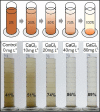The effect of various metal-salts on the sedimentation of soil in a water-based suspension
- PMID: 31935229
- PMCID: PMC6959554
- DOI: 10.1371/journal.pone.0227338
The effect of various metal-salts on the sedimentation of soil in a water-based suspension
Abstract
Soil particles and bound nutrients that erode from agricultural land may end up in surface waters and cause undesirable changes to the environment. Various measures, among them constructed wetlands have been proposed as mitigation, but their efficiency varies greatly. This work was motivated by the assumption that the induced coagulation of particles may accelerate sedimentation in such wetlands and by that help reduce the amount of material that is lost from the vicinity of the diffuse source. Our specific aim was to laboratory-test the effectiveness of various salt-based coagulants in accelerating the process of sedimentation. We tested the effect of Na+, Mg2+, Ca2+, Fe3+ and Al3+ cations in 10, 20, 40 and 80 mg L-1 doses added to a soil solution in select, soluble forms of their chlorides, sulphates and hydroxides. We mixed such salts with 1 gram of physically dispersed, clay and silt rich (>85% in total) soil material in 500 mL of solution and used time-lapse photography and image analysis to evaluate the progress of sedimentation over 3 hours. We found that 20-40 mg L-1 doses of Mg2+, Ca2+ in their chloride or sulphate forms appeared to provide the best consensus in terms of efficiently accelerating sedimentation using environmentally present and acceptable salts but keeping their dosage to a minimum. Comprehensive in-field efficiency and environmental acceptability testing is warranted prior to any practical implementation, as well as an assessment of small scale economic and large-scale environmental benefits by retaining soil and nutrients at/near the farm.
Conflict of interest statement
The authors have declared that no competing interests exist.
Figures






References
-
- Lundekvam H, Skoien S. Soil erosion in Norway. An overview of measurements from soil loss plots. Soil Use and Management. 1998; 14(2): 84–89.
-
- Uusi-Kamppa J, Braskerud B, Jansson H, Syversen N, Uusitalo R. Buffer Zones and Constructed Wetlands as Filters for Agricultural Phosphorus. J. of Env. Quality. 1998; 29(1): 151–158.
-
- Blankenberg AGB, Haarstad K, Paruch AM. Agricultural Runoff in Norway: The Problem, the Regulations, and the Role of Wetlands In: Vymazal J. (ed.) The Role of Natural and Constructed Wetlands in Nutrient Cycling and Retention on the Landscape. Springer, Cham: 2015; 137–147. 10.1007/978-3-319-08177-9_10 - DOI
-
- Braskerud BC, Lundekvam H, and Krogstad T. The Impact of Hydraulic Load and Aggregation on Sedimentation of Soil Particles in Small Constructed Wetlands. Journal of Environmental Quality. 2000; 29(6): 2013–2020. 10.2134/jeq2000.00472425002900060039x - DOI
-
- Sveistrup TE, Marcelino VM, Braskerud B. Aggregates explain the high clay retention of small constructed wetlands: A micromorphological study. Boreal Environment Research. 2008; 13(6): 275–284.
Publication types
MeSH terms
Substances
LinkOut - more resources
Full Text Sources
Miscellaneous

